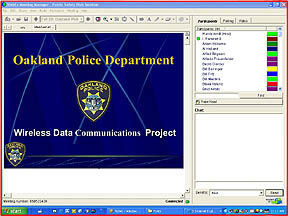
On March 11, 2003 the Oakland Police Department, in conjunction with Panasonic, XcelleNet and PadCom presented a "Public Safety Web Seminar" on the department's wireless data communications project, specifically the outfitting of police motorcycles with computers and wireless communication. In an impressive use of communications technology, this was not just a conference call or some public gathering in a shabby meeting room. No, it was a high tech presentation using the WebEx Online Meetings and Web Conferencing system complemented by a voice conference call to listen in on the audio part of the presentation. WebEx (www.webex.com) is a terrific system that divides the display into a main window for a slide presentation and a number of secondary windows that show participants, polling, video, and chat/questions (see image above). I had never attended a webex meeting and it was a totally impressive experience. To see that kind of sophistication in a presentation by a local law enforcement agency was both impressive and reassuring (if they can do THAT, they must be a well organized and managed machine).
I should also mention that the images you see in this report were captured with Microsoft's incredibly useful "Snipping Tool" for Tablet PCs, running on my Toshiba Portege 3500 Tablet PC notebook. With it I could simply draw a circle around interesting parts of the presentation and jot down comments. Click on each graphic to get a full-size version.
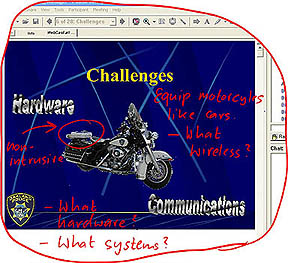 Hosted by Xcellenet's Randy Arndt, the presentation was made by Officer Inez Ramirez of the Oakland police. Ramirez described the department's wireless data communications project which he is in charge of. Oakland had been using wireless data communication and laptops in over 200 patrol cars for about two years and they wanted to extend wireless to motorcycles as well. A grant enabled this project. Ramirez described the evaluation process and its challenges. While applications were a given, they needed to decide on the proper hardware as well as a suitable, stable wireless communications system. The force already had a good deal of experience with their older proprietary Motorola RD-LAP private wireless systems but wanted a faster system that could work in conjunction with RD-LAP. They eventually chose to go with public service providers and a CDPD-based system. Ramirez pointed out that they were well aware of CDPD's limitations and eventual replacement, but they already had a large investment in DCPD hardware and software and thus decided to use it in a system that would allow replacement with newer wireless technologies.
Hosted by Xcellenet's Randy Arndt, the presentation was made by Officer Inez Ramirez of the Oakland police. Ramirez described the department's wireless data communications project which he is in charge of. Oakland had been using wireless data communication and laptops in over 200 patrol cars for about two years and they wanted to extend wireless to motorcycles as well. A grant enabled this project. Ramirez described the evaluation process and its challenges. While applications were a given, they needed to decide on the proper hardware as well as a suitable, stable wireless communications system. The force already had a good deal of experience with their older proprietary Motorola RD-LAP private wireless systems but wanted a faster system that could work in conjunction with RD-LAP. They eventually chose to go with public service providers and a CDPD-based system. Ramirez pointed out that they were well aware of CDPD's limitations and eventual replacement, but they already had a large investment in DCPD hardware and software and thus decided to use it in a system that would allow replacement with newer wireless technologies.
After a detailed evaluation phase, the department selected Padcom, Xcellenet, and Panasonic as partners for this project.
Padcom, Inc. offers modular software for wireless data networks that simplifies information flow for mobile users and makes it largely transparent.
Xcellenet specializes in meeting the challenges of distributed networks. The Xcellenet flagship product, RemoteWare, enables enterprises to securely deliver and maintain mission-critical applications and data to remote locations. Xcellenet's Afaria server manages mobile devices, content and applications from a central location and ended up being used by the Oakland Police Department project.
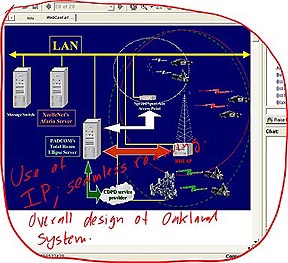 The department concluded that a wireless LAN was the best way to provide the large bandwidth they needed. The solution was to create a citywide network of wireless WLAN access points. When in range of an access point (two to two-and-a-half blocks) officers could send and receive data at very high speed. When out of range they would continue to use the older private RF network. Padcom's Intelligent Mobile Routing solution enabled data to be transmitted over seemingly incompatible wireless networks without the need for the officers to reconfigure anything or use different systems.
The department concluded that a wireless LAN was the best way to provide the large bandwidth they needed. The solution was to create a citywide network of wireless WLAN access points. When in range of an access point (two to two-and-a-half blocks) officers could send and receive data at very high speed. When out of range they would continue to use the older private RF network. Padcom's Intelligent Mobile Routing solution enabled data to be transmitted over seemingly incompatible wireless networks without the need for the officers to reconfigure anything or use different systems.
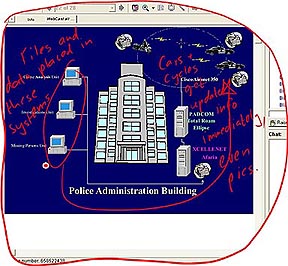 Another challenge was to guarantee safe delivery of critical information through this wireless system. Not only was there a need to move a variety of different files and data through the network, but with motorcycles moving around constantly in and out of range of an access point, there was a need for a system that could manage partial downloads and pick them up once an officer was within reach of the next access point. Xcellenet's system and file management solution turned out to be perfect for moving and managing all those files, install updates, and so on.
Another challenge was to guarantee safe delivery of critical information through this wireless system. Not only was there a need to move a variety of different files and data through the network, but with motorcycles moving around constantly in and out of range of an access point, there was a need for a system that could manage partial downloads and pick them up once an officer was within reach of the next access point. Xcellenet's system and file management solution turned out to be perfect for moving and managing all those files, install updates, and so on.
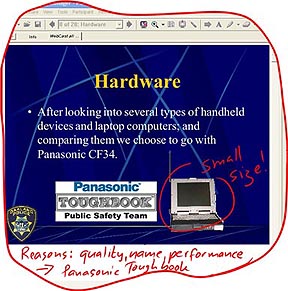 In terms of hardware, the Oakland Police Department already had a relationship with Panasonic as they had been using Toughbook CF-27 rugged notebooks in police cruisers. After looking at several types of handheld devices and laptop computers, they decided to go with Panasonic's Toughbook CF-34 with Sierra Wireless CDPD modems. The CF-34, while using a more than adequate 850MHz mobile Pentium III processor, is small and compact enough to fit into a special enclosure mounted on the back of the police motorcycles. Officer Ramirez stressed quality, performance, and Panasonic's overall good name as primary reasons for the selection and also pointed to excellent warranty and service provided by Panasonic's Heartland service facility that offers 24/7 phone support and an average service turnaround of just 1.5 days.
In terms of hardware, the Oakland Police Department already had a relationship with Panasonic as they had been using Toughbook CF-27 rugged notebooks in police cruisers. After looking at several types of handheld devices and laptop computers, they decided to go with Panasonic's Toughbook CF-34 with Sierra Wireless CDPD modems. The CF-34, while using a more than adequate 850MHz mobile Pentium III processor, is small and compact enough to fit into a special enclosure mounted on the back of the police motorcycles. Officer Ramirez stressed quality, performance, and Panasonic's overall good name as primary reasons for the selection and also pointed to excellent warranty and service provided by Panasonic's Heartland service facility that offers 24/7 phone support and an average service turnaround of just 1.5 days.
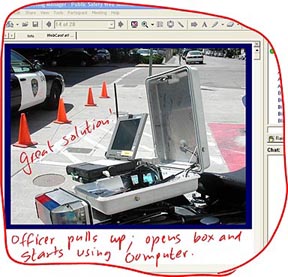 What they ended up with was a system that provides officers on patrol with a wealth of information that had either not been available before, or had to be distributed via paper flyers called Officer Safety Bulletins. Those bulletins are the result of queries of state and federal databases on criminals and missing persons. The wireless systems automatically loads pdf versions of those bulletins onto the Toughbook computers mounted on the officer's motorcycles. Having that information available, in addition to all sorts of other data transparently and securely transmitted from special shared folders in the departments can make the difference between life and death. The bottomline is that officers now get all that data, including pictures in crisp , upo-to-date pdf files that are uploaded and updated whenever they get in range of an access point. There is not even a need for loading data from a CD-ROM.
What they ended up with was a system that provides officers on patrol with a wealth of information that had either not been available before, or had to be distributed via paper flyers called Officer Safety Bulletins. Those bulletins are the result of queries of state and federal databases on criminals and missing persons. The wireless systems automatically loads pdf versions of those bulletins onto the Toughbook computers mounted on the officer's motorcycles. Having that information available, in addition to all sorts of other data transparently and securely transmitted from special shared folders in the departments can make the difference between life and death. The bottomline is that officers now get all that data, including pictures in crisp , upo-to-date pdf files that are uploaded and updated whenever they get in range of an access point. There is not even a need for loading data from a CD-ROM.
 Officer Ramirez stressed the importance of technology that helps officers in the field rather than being an additional burden by requiring lengthy training or too many steps to get to the data when on duty. He also said that in his capacity as project coordinator a large part of his work was to make sure that the needs of the officers were met, and that the vendor deliverables were actually what they had contracted for. He praised all three partners -- Panasonic, Xcellenet, and PadCom -- for excellent teamwork, a proactive approach, and a willingness to accommodate the Oakland Police Department's needs and requests.
Officer Ramirez stressed the importance of technology that helps officers in the field rather than being an additional burden by requiring lengthy training or too many steps to get to the data when on duty. He also said that in his capacity as project coordinator a large part of his work was to make sure that the needs of the officers were met, and that the vendor deliverables were actually what they had contracted for. He praised all three partners -- Panasonic, Xcellenet, and PadCom -- for excellent teamwork, a proactive approach, and a willingness to accommodate the Oakland Police Department's needs and requests.
Question: Can the system be used in the rain?
Answer: Toughbooks are weather resistant and they are sealed in specially designed radio boxes. When it's raining hard, the police force uses vehicles and not motorcycles, so officers would not open and use the boxes in pouring rain. However, past experience with Panasonic Toughbooks is what made them choose them.
Question: Did the Department test durability?
Answer: Yes, a lot of ruggedized laptops were looked at and evaluated. Again, their past experience with the Panasonic CF-27 rugged notebooks was very good, and this prior experience weighed heavily in the selection of Panasonic.
Question: What encryption is used on the 802.11b LANs.
Answer: Standard WAP 128-bit encryption, MAC address filtering CISCO software. PadCom tunneling from client to server, 256-bit encryption via PadCom.
Question: When moving out of range of an Access Point, what happens?
Answer: The Xcellenet Afaria server has intelligence to remember partially downloaded files and will pick up where they left off. So when the officers comes in range again, the download resumes.
Question: Screen visibility?
Answer: They are happy with the displays. They looked at highbright and newer transflective displays. The officers decided that since 85% of the use was outside, they wanted the transflective displays.
Question: What new technology will replace CDPD?
Answer: No definite decision yet.
Question: Did they consider systems other than Xcellenet?
Answer: Yes, they had looked at mobile Flash solutions and also one by Motorola. All did file updating, but additional features by Xcellenent closed the deal.
Question: How many units are deployed?
Answer: 235 in cars and now they are adding 40 on motorcycles.
Question: Coverage radius of 802.11b cells?
Answer: About 2 to 2-/12 blocks
Question: What modems do they use? Is RF exposure an issue for officers?
Answer: They use Sierra Wireless CDPD modems and CISCO Aironet 350s in PC Card slots. Wireless emissions are well below any dangerous threshold.
Question: Can officers run inquiries through the system?
Answer: Yes, they can do that.
Question: Was there a problem coordinating with three vendors, Pana, PadCom, and Xcellenet?
Answer: No problem at all. All have been very open. All were open to making changes and accommodating requests.
Question: Use for voice, IM, or email in future?
Answer: The Department is looking at many options, including streaming video for netmeetings and such. Budget crunch is slowing things down. But the base they built provides flexibility for future possibilities. Interested in Internet email (not Internet access).
Question: Panasonic uses mobile processors. Do they have enough horsepower?
Answer: 850MHz is decent enough for what they run and they maxed out RAM in the CF-34s. The CF-34s perform well beyond the specs of the applications they are running The traffic accident software, Afaria, and everything they use is working great.
For a detailed Xcellenet case study of the Oakland Police Department project, see http://www.xcellenet.com/public/pdfs/products/afaria/literature/success/Oakland.pdf)
For a detailed Padcom case study of the Oakland Police Department project, see http://padcomusa.com/stories/oakcase.html)
In closing I should mention that, in my opiniion, adding Tablet PC functionality to systems such as the one implemented by Oakland's Police Department would enhance their already considerable usefulness. Officers could mark up images and reports, and the marked up pictures would immediately be available to headquarters. Likewise, they could use digital cameras, or digital camera attachments, to capture images of crime or accident scenes, mark them up, and upload those immediately. The use of electronic ink could thus greatly add to communication between officers on the road and police headquarters.














